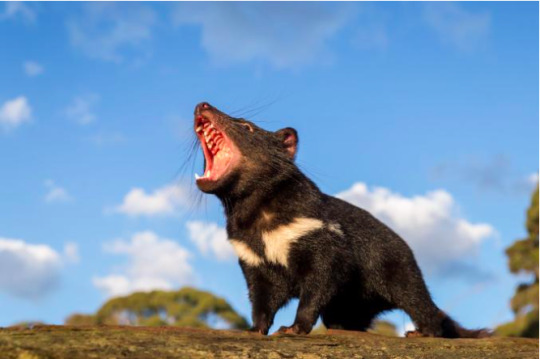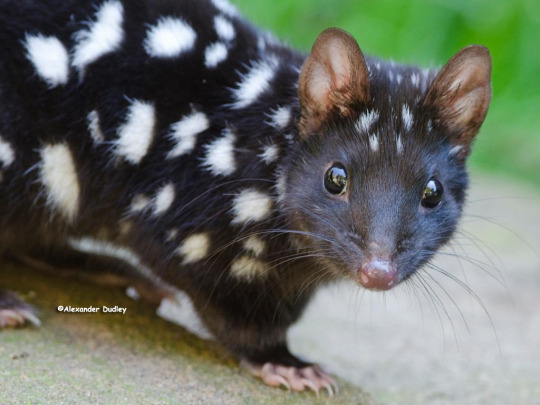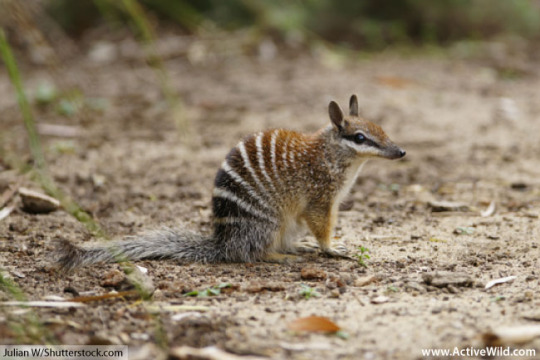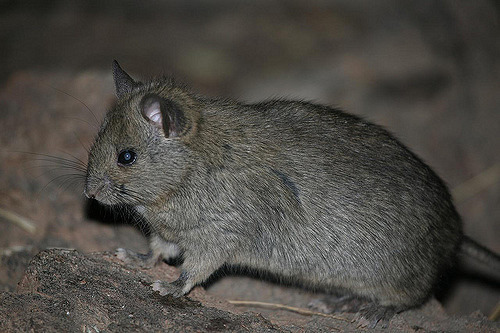#rufous bettong
Text
Nonreproductive REVERSE mounts – in which females mount males – occasionally occur in this species, as do attempted mounts by males on females who are not in heat.
"Biological Exuberance: Animal Homosexuality and Natural Diversity" - Bruce Bagemihl
#book quote#biological exuberance#bruce bagemihl#nonfiction#mounting#rufous bettong#rat kangaroo#aepyprymnus rufescens
0 notes
Text
Tree Kangaroos and Rufous Bettongs are largely solitary, although they sometimes associate in pairs, trios, or small groups of adults and their young.

"Biological Exuberance: Animal Homosexuality and Natural Diversity" - Bruce Bagemihl
#book quotes#biological exuberance#bruce bagemihl#nonfiction#rufous bettong#rat kangaroo#aepyprymnus rufescens#doria's tree kangaroo#dendrolagus dorianus#matschie's tree kangaroo#dendrolagus matschiei#solitary#pair#trio#small group
0 notes
Text
Female Rufous Bettongs that participate in homosexual behavior are probably bisexual, since most mate with males and become successful mothers.
"Biological Exuberance: Animal Homosexuality and Natural Diversity" - Bruce Bagemihl
#book quote#biological exuberance#bruce bagemihl#nonfiction#rufous bettong#rat kangaroo#aepyprymnus rufescens#bisexual#successful mother
0 notes
Photo

Ida and Wayne are each other’s emotional support animals.
55 notes
·
View notes
Link
Cute mammals, protected from cats now. See photos.

A critically endangered mala or rufous hare wallaby in the feral predator-proof fenced area on Newhaven Wildlife Sanctuary. Photograph: Wayne Lawler/Australian Wildlife Conservancy
Excerpt:
The world’s largest cat-proof fence has been completed in central Australia, creating a 94 square kilometre sanctuary for endangered marsupials.
The 44km fence – made of 85,000 pickets, 400km of wire and 130km of netting – surrounds the Newhaven wildlife sanctuary, a former cattle station that has been bought by the Australian Wildlife Conservancy.
Endangered species such as the bilby, the burrowing bettong and the mala (also known as the rufous hare-wallaby) will have a chance to replenish their populations inside the massive sanctuary, safe from Australia’s feral cat epidemic.
Feral cats kill a million native birds every night across Australia and have caused the extinction of 20 native species since they were introduced by the first fleet.

Bilby

Burrowing bettong
#endangered species#animals#australia news#wildlife#conservation#feral cats#bilby#burrowing bettong#mala#rufous
3K notes
·
View notes
Photo

Tasmanian devils, known for their ferocious temperaments, have been plagued by a contagious facial cancer in recent decades.
Tasmanian devils return to mainland Australia for first time in 3,000 years
Scientists hope the scrappy predators' reintroduction can balance ecosystems ravaged by invasive species.
JASON BITTEL
OCTOBER 5, 2020
It’s been 3,000 years since the Tasmanian devil’s raspy shriek rang through the forests of mainland Australia. But now, thanks to a dogged reintroduction effort, 26 of these endangered tiny terrors have returned.
No bigger than a lapdog, these marsupials are famous for their ferocity and powerful jaws, which can reduce large carcasses to smithereens in minutes. But in the 1990s, the species was hit with a contagious and deadly mouth cancer, causing its only remaining wild population, on the Australian island state of Tasmania, to drop to just 25,000 animals.
It’s unknown why the species disappeared from Australia millennia ago, but it’s likely due to human actions—when early hunters killed off most of the continent’s megafauna, the devils had nothing left to eat.
As scavengers, devils play a crucial role in maintaining a balanced, healthy ecosystem—which is why scientists have been trying so hard to bring them back.
“We've worked for over a decade to get to this point,” says Tim Faulkner, president of AussieArk, a species recovery organization. The group collaborates closely with the nonprofits Global Wildlife Conservation and WildArk to orchestrate the release of captive-raised animals into a thousand-acre fenced area called Barrington Wildlife Sanctuary, just north of Barrington Tops National Park in eastern Australia.
Despite their fearsome reputation, “they’re no threat to humans or agriculture,” he adds.
Tasmanian devils, Sarcophilus harrisii
Even still, reintroducing animals is uncertain business, so the scientists did a soft launch of 15 devils in March of this year. The team used radio-collars to check in on the released devils, as well as put out kangaroo carcasses for food as the animals adjusted to their new home. After all of the devils showed signs of thriving, the scientists felt optimistic enough to release another 11 individuals on September 10—and now they beasts are mostly on their own.
“They're free. They're out there,” says Faulkner. “We’ve got some basic means of keeping an eye on them. But essentially, now it's over to the devils to do what they do.”
Fighting off invaders
To prepare for the devils’ arrival, Faulkner’s team fenced off a large chunk of protected eucalyptus forest, took out invasive plants, cleared leaf litter that can lead to forest fires, and used humane lethal control to remove red foxes and feral cats—introduced predators that have devastated the continent’s small mammal populations. (Read how quolls, a cat-size marsupial, were reintroduced to mainland Australia.)
Tasmanian devils enter their new home in the eucalyptus forests of eastern Australia.
Feral cats don’t prey on the devils—in fact, it’s the felines that might need to be concerned.
“The presence of devils on the landscape seems to put the cats off a bit,” says David Hamilton, a devil expert and research assistant at the University of Tasmania who was not involved in the reintroduction project. Devils don’t usually eat cats, but instead force them to hunt during dusk and dawn to avoid run-ins with the nocturnal devils.
It may seem minor, but this small shift in behavior can actually protect night-dwelling native species, such as bandicoots, several species of which are considered endangered in Australia. Interestingly, bandicoot populations increase where devils are more prominent than cats, says Hamilton. (Learn more about invasive species and their impact on the environment.)
This is exactly what Faulkner and others hope Tasmanian devils will do Australia—stabilize the continent’s ecosystems against invaders.
But it’s “a big unknown” what will happen when the devils go up against red foxes, which are larger than cats and more equal in size to devils, Hamilton cautions.
There’s also the question of whether reintroducing devils will have unforeseen consequences for other sensitive species. For instance, in 2012, an introduced population of devils in Maria Island, off the coast of Tasmania, led to the disappearance of several short-tailed shearwater colonies.
Feral cats and common brushtail possums, both non-native to the island, were already preying upon the seabirds, and though the devils started suppressing those predators, they also began eating the seabird eggs and hatchlings too.
“Theoretically, they shouldn’t have a negative impact [in Australia],” says Hamilton. “But you have to think about the entire ecosystem when you’re doing things like this, and that’s a big ask.”
This is why it’s particularly important that the reintroduction is starting off inside an expansive but fenced-off environment, he adds.
‘Ecological blink of an eye’
Assuming all goes well, the triad of conservation organizations plans to release 40 additional devils into the same protected forest over the next two years. And they’ll have company.
As the ferocious Tasmanian devil battles a fatal cancer outbreak, Australian biologists are breeding a viable, cancer-free population in captivity.
Since removing the cats and foxes, Faulkner’s team has also begun releasing other imperiled native species into the same habitat, including Parma wallabies, long-nosed bandicoots, long-nosed potoroos, and rufous bettongs. (Learn about the silent decline of the platypus, Australia’s beloved oddity.)
AussieArk plans to release even more of those species over the next six months, in addition to eastern quolls, brush-tailed rock wallabies, and southern brown bandicoots.
These tiny mammals are crucial to keeping their environment clean and healthy by dispersing seeds and reducing wildfire intensity by digging up leaf litter and speeding up its decomposition.
“It really comes down to these smaller, terrestrial ecosystem engineers that turn over leaf litter,” Faulkner says. “A bandicoot turns over an elephant’s [weight] of soil each year. One bandicoot.”
If the experiments prove successful, there are 370,000 acres of protected land nearby into which the reintroductions could expand, he adds.
“I really believe that over time, we'll see the devil become a normal part of mainland Australia,” says Faulkner. “It was here 3,000 years ago. You know, that's an ecological blink of an eye.”
3 notes
·
View notes
Text
The Rufous Bettong
#doodlewashMay2022: Scale. The bettongs are kangaroo rats – small in scale next to kangaroos, but the largest of the kangaroo rats.
Did you know the rufous bettongs scientific name (Aepyprymnus rufescens) means “reddish high-rump”? Despite their reddish name, they range in color from reddish brown to pale gray.
Hahnemühle Hot Press The Collection watercolor paper Zebra Technical PenDaniel Smith…

View On WordPress
#DanielSmithArtistMaterials#doodlewashMay2022#PostcardsForTheLunchBag#WorldWatercolorGroup#ZebraAmbassador#ZebraPen#ZebraPenUS#ZebraPen_USA#@Hahnemühle FineArt#@Hahnemühle_USA#@zebrateam_usa#Bettong#Doodlewash prompts#Kangaroo Rat#Watercolor
0 notes
Text
Australian Mammals that you didn’t know existed
You hear a lot about Kangaroos and Koalas and such, so I thought I’d post some animals that are unknown to lots of people, even some Aussies don’t realise we have them. Sadly most of these are on the endagered species list.
Also some fun facts added so you can have an idea of how awesome they are.
Quolls

Considered Australia’s ‘native cat’ these guys are carnivorous marsupials and have the ability to bite through bone.
‘Quoll’ is an Aboriginal term meaning tiger cat (although they have spots not stripes so I think we translated wrong)
If you find an animal that has been killed an turning inside out, it’s probably been eaten by a Quoll. These guys use their nimble hands to get to the yummy meat and bones and avoid all the fur, very clever!
4 species; Eastern Quoll, Spotted-Tailed Quoll (or Tiger Quoll), Western Quoll (or chuditch) and Northern Quoll. ranging in size from 25cm to 75 cm long.
Kultarr

Cute little insect eaters, again a marsupial. Can move at speeds of around 13km/hr. Only about 10cm long.
So damn cute, look at that tail!
Bettongs

Marsupial. Of which there are 5 species (and at least another 2 extinct); Eastern Bettong, Boodie, Woylie, Northern Bettong and Rufous Rat-Kangaroo (or Rufous Bettong).
They seem to get along well with wombats, where I work they enter the wombat exhibits of a night to share their food.
Bilby

Marsupial. There was once 2 species of Bilby, sadly the Lesser Bilby became extinct in the 1950s and the Greater Bilby is greatly endangered.
In the same family as Bandicoots.
Omnivores with backwards facing pouches (as they dig a lot this stops dirt getting in their pouch).
Australian’s know these guys through the story of the Easter Bilby. Rabbits are considered a major reason for their decrease in numbers as they eat all the food and out-breed the Bilbies.
Numbat

Marsupial. Aka the banded anteater or Walpurti.
Mainly eats termites.
Emblem of Western Australia. Up to 45cm long.
One of the few marsupials that are diurnal (active of a day).
Eats up to 20,000 termites each day.
Estimated population of less than 1000.
Grey-Headed Flying Fox

Aka Fruit Bat. Placental mammal. Called a flying fox because they have a fox-like face and can fly.
Babies are called pups.
Megabat.
Wingspan of about 1m.
May travel 50kms in one night for food. Eats pollen, nectar, sap and fruit. Long distance seed distributors and plant pollenators. Each colony plants around 30,000 trees a night. Without these guys we don’t have any of our lovely bush and ecosystem that we all rely on.
Have very good eyesight and no echolocation.
Greater Stick-Nest Rat

Placental mammal.
Up to 26cm long.
Don’t have a ratty face.
Were extinct on the mainland but through breeding programs have been re-introduced.
Herbivores.
Chew branches to length and weave them together to make a nest which can be up to 1m high and 1.5m wide.
Other unknown Australian Mammals you can look up:
Antechinus
Pygmy Possum
Feathertail Glider (smallest glider in the world)
Southern Ningaui
Greater Glider
Potoroos
Pademelons
Eastern False Pipistrelle
Sadly lots of these could go extinct in our lifetime, and people haven’t even had the chance to really get to appreciate them yet.
**PS the Koala is also in danger of becoming extinct in the wild
#Australian Mammals#Aussie Animals#Mammals#Marsupials#Bilby#Numbat#Rat#Bat#Flying Fox#Bettong#Quoll#Kultarr#the more you know#education#animals#Endangered#all credit to the people who took the photos
9K notes
·
View notes
Video
instagram
Some inside bonding for this little Rufous Bettong boy. Those little T. rex arms ☺️
1 note
·
View note
Text
If the other female calms down, the courting female may mount her by clasping her waist from behind and thrusting against her.
"Biological Exuberance: Animal Homosexuality and Natural Diversity" - Bruce Bagemihl
#book quote#biological exuberance#bruce bagemihl#nonfiction#rufous bettong#rat kangaroo#aepyprymnus rufescens#courtship#mounting#lesbian
0 notes
Text
<a href="http://gossipslab.com/rufous-bettong-red-bellied-blacks-and-crocs-make-first-appearances-at-hartleys-crocodile-adventures-in-cairns">Rufous bettong, red-bellied blacks and crocs make first appearances at Hartley’s Crocodile Adventures in Cairns</a><br /> Huge barra caught during Tinaroo fishing competition goes into the record booksA TRIO of the Far North’s most iconic animal species have entered the world at Hartley’s Crocodile Adventures. A rufous bettong joey, a knot of red-bellied black snake babies and about 800 crocodile hatchlings are the ...
Rufous bettong, red-bellied blacks and crocs make first appearances at Hartley’s Crocodile Adventures in Cairns
Huge barra caught during Tinaroo fishing competition goes into the record booksA TRIO of the Far North’s most iconic animal species have entered the world at Hartley’s Crocodile Adventures. A rufous bettong joey, a knot of red-bellied black snake babies and about 800 crocodile hatchlings are the ...
0 notes
Video
instagram
One of our rufous bettongs with a hyperactive joey in pouch ☺️🙈
1 note
·
View note